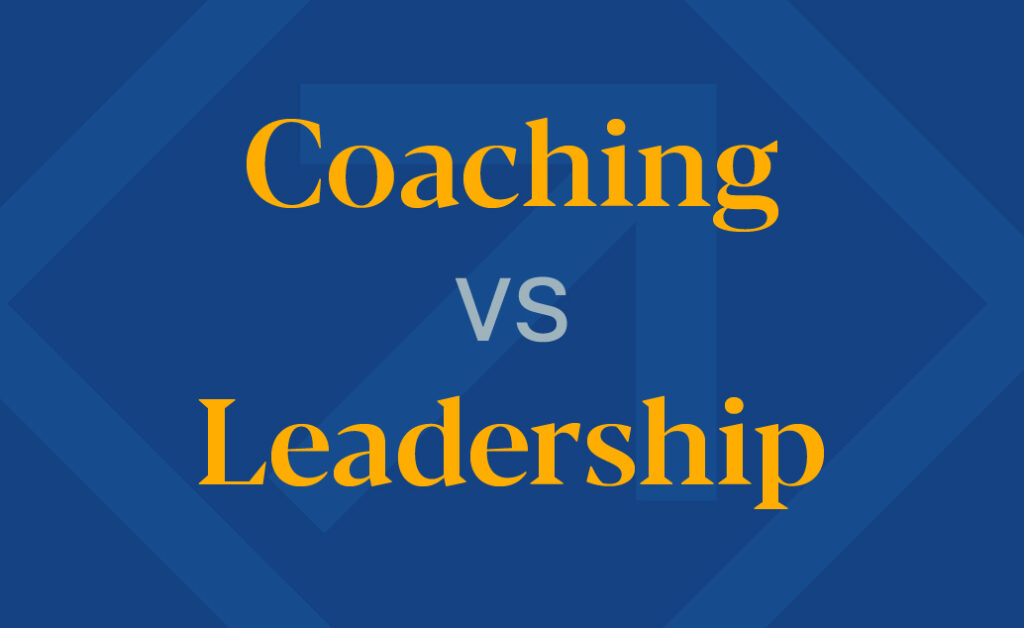
What is coaching? What is leadership? Are they one and the same? Does one imply the other? Coaching and leadership may both be imagined as important processes within the professional world, but they can be defined differently depending on the context. For our purposes, we’ll explore both coaching and leadership, highlighting what each is and how these differ and are similar.
What Is Coaching?
The International Coaching Federation defines coaching as “partnering with clients in a thought-provoking and creative process that inspires them to maximize their personal and professional potential. The process of coaching often unlocks previously untapped sources of imagination, productivity and leadership.” This definition implies a professional relationship as an important facilitator of the coaching process.
Key Principles of Coaching
We’ve defined what coaching is, but what does it look like operationally? The Center for Creative Leadership outlines six core principles that facilitate a strong coaching relationship. Many of these principles reside with the coach, as they are responsible for leading the relationship:
- Creating a safe and challenging learning environment: This is one of the most critical parts of the coaching relationship, especially in its foundations, as clients must feel safe. The experience of safety and belonging in the relationship enables clients to be vulnerable and honest during interactions, ultimately leading to setting authentic goals. People learn better in an environment that feels safe for learning and growth. Safety is important because it allows clients to commit to challenging themselves in whatever capacity and context.
- Working with the client’s agenda: This is also an important consideration in effective coaching practice so they can help clients solve problems. It is often very easy to become a bit swell-headed because of the assumed power dynamic in the coach-client dynamic, leading to the coach driving the relationship. However, coaching should be driven by the client. The coach needs to respect the client’s goals and co-construct the pathway to attaining those goals.
- Facilitating and collaborating: Following working with the client’s agenda, this co-construction within the coaching relationship should be comprised of continuous facilitation and collaboration. Coaching is not about teaching; it is not about right or wrong. Coaching is about collaborating with the client to help them realize their needs and goals to facilitate the appropriate course of action.
- Advocating self-awareness: It is important for coach and client to foster self-awareness, highlighting both areas of strength and areas for improvement. Following the co-constructive model, both stakeholders need to be actively engaged in this process. Greater self-awareness of the coach influences the self-reflective abilities of the client, resulting in a relationship that generates more strategic relationship building and goal setting.
- Promoting learning from experience: One of the most profound principles, learning from past experiences, is crucial to progressing toward goals. Some of the most influential developmental and learning theorists, including Jean Piaget and Lev Vygotsky, and theories – including problem-based learning, social learning theory and constructivist learning theories – all support the power and impact of prior experiences. Integrating this into the coaching process sets the stage for a successful relationship.
- Modelling: It is also important that the coach emulates and models the behaviors that they are trying to influence within the client. Coaches often operate from a philosophy of coaching (much like a teaching philosophy), which informs their core beliefs about the coaching process and how it should be operationalized. If that philosophy is constructively aligned with professional practice, a coach would naturally be a model for what they preach.
What Is Leadership?
We’ve explored pretty extensively what coaching is and what it looks like to do it well. Let’s turn to leadership. Leadership is not very easily defined. In fact, it’s been one of the most contested and researched concepts in leadership literature. There is not a universal definition because it varies depending on its theoretical origin. Some of the common leadership theories include transformational, transactional, participative, servant and authentic. For our purposes, we’ll proceed with an oversimplified version of defining leadership as the processes that inform how one leads.
What Makes a Great Leader?
There are a range of qualities and characteristics that make a great leader. The Center for Creative Leadership highlights these qualities, which include:
- Self-awareness, respect and compassion: Self-awareness refers to an honest reflectivity of self, including strengths and weaknesses, which hold deep value: Leaders who knows themselves well are positioned to be stronger leaders. Respect and compassion are also important qualities in a leader, as these inform a healthy relationship between leaders and followers.
- Vision, communication and learning agility: Another quality of a strong leader entails vision, which is mediated by communication. A vision is important to foster cohesion toward a common goal, and communication is the main tool that facilitates this work toward the vision. Learning agility is of particular importance because leaders who possess this quality thrive in crisis management and in figuring out what to do in unfamiliar situations.
- Collaboration, influence and integrity: Strong leaders foster collaboration across their followers and teams toward developing greater collective and social identity as well as greater connections among teams. Further, they are highly influential and understand how to appropriately and respectfully use charisma and other influential tactics to persuade when the need arises. This persuasion is not to be used for unethical purposes, which is why integrity is also an important quality referring to the guiding moral principles that a leader should embody.
- Courage, gratitude and resilience: Great leaders are courageous and possess the strength to assert themselves even in situations when it may be difficult to do so, which may inspire their followers and team. They also demonstrate gratitude as a form of humility and act resiliently, not just in terms of bouncing back from tough situations but reacting very adaptively to situations that may be difficult to navigate. The development and fostering of resilience are highly related to learning agility.
Coaching and Leadership: Similarities and Differences
We’ve looked extensively at both coaching and leadership, how we define each and what qualities comprise a strong coach and leader. Let’s look at a concept comparison at a glance.
Similarities
Let’s first look at some of the similarities between these two concepts:
- Grounded in motivational and affective theories: Both coaching and leadership are rooted in theories of motivation and emotion. Motivational theories are especially prominent, as both the leader and the coach must be able to motivate their followers and clients toward realizing goals and the actions needed to get to that point. The emotional component also plays a critical role in both the coaching and leadership processes, as humans are emotional beings. We are constantly interacting and navigating complex emotions throughout our everyday processes, even within the context of coaching and leading.
- Focused on outcomes: Both coaching and leadership are also focused on outcomes. They both emphasize working toward goals and the actions necessary to accomplish those goals.
- Emphasized collaboration: Collaboration is key in both coaching and leadership. Collaboration must occur between coach and client and also between leader, followers and teams, and amongst the team members. It’s pivotal to move toward accomplishing goals.
- Self-awareness: Coaching and leadership requires a deep understanding and awareness of how self plays a huge role in the professional processes. Self-awareness, at the levels of both coach and leader, and client and follower, is paramount for successfully navigating relationships and goals.
Differences
Now that we’ve covered some of the similarities between coaching and leadership, let’s look at some of the differences:
- Operationalizing change: Coaching and leadership rely on different versions of change. Given that the nature of coaching relationships tends to operate at more of a personal and micro-level, and leadership is much more of a macro-process, how they visualize change varies. Coaches tend to focus more on short-term changes that support a bigger goal, whereas leaders are more focused on institutional-level macro changes.
- Problem-solving: Considering the difference in how they operationalize change, coaches and leaders also approach problem-solving differently. Coaches problem-solve through more intimate co-constructive methods, while leaders tend to provide more conceptual and motivational support toward devising appropriate actions for group-level problems.
- Decision-making: Coaches follow a collaborative decision-making process, as the client drives the majority of decisions within the coaching relationship with the facilitation of the coach’s expertise. Leaders are often in positions where there is less room for joint efforts in decision-making, often resulting in decisions that can be perceived as top-down in nature.
- Hierarchy of relationships: The personal and intimate nature of the coaching relationship means there is a much more lateral distribution of power because of an intertwining of processes. Leaders assume a much more vertical distribution of power because of the magnitude of teams they usually have to lead.
Developing Leadership and Coaching Skills
Becoming a leader or coach not only requires hands-on experience and time, but intentional learning of educational theory. This can come in the form of a degree program or even opportunities within your current role that prepare you to elevate into a higher position. For example, I completed the M.Ed. in Higher Education with a focus in Leadership at American College of Education to equip me for my next level of work and scholarship in the field of education.
Ultimately, educational theory encompasses the variety of approaches that are applicable to coaching and leadership. Diving deeply into them allows aspiring coaches and leaders to determine how they’ll execute their practice and expertise while also gaining an understanding of the learning approaches of individuals they’ll lead.
In Conclusion
Coaching and leadership are both critical processes and have their places in their respective contexts. Reflecting on my own journey as a coach and leader, I recognize many of these principles that I’ve incorporated in my practice. I had to learn how to make them work together to better support my clients and teams. The practice of both coaching and leadership requires attentiveness and intentionality to evolve through the processes toward becoming the best coach and leader possible.
Become the leader you aspire to be with the leadership programs at American College of Education.

